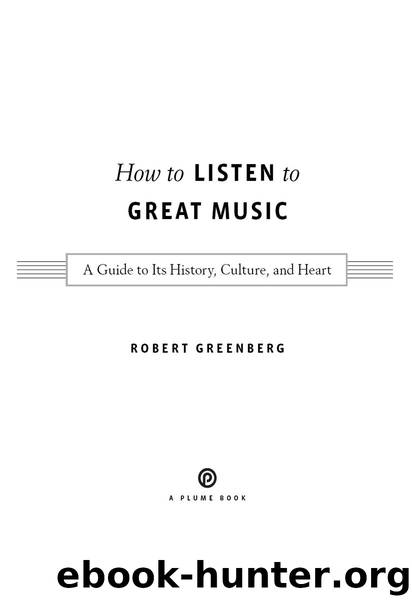How to Listen to Great Music by Robert Greenberg

Author:Robert Greenberg
Language: eng
Format: epub, mobi
Publisher: Penguin Group US
Published: 2011-11-24T05:00:00+00:00
* * *
The Piano
In discussing the piano, we again run into some rather confusing terminology, as we encounter the completely interchangeable words pianoforte, fortepiano, and piano. Generally, we use the term fortepiano to refer to early pianos, pianos made with wooden harps between about 1710 and 1830, and the terms pianoforte, or simply piano, for metal harped pianos, built from around 1825 to the present day. We’ll run with this distinction with the understanding that, in reality, these three terms refer to the same instrument.
The first working drawings for what today we call a piano date to around 1700. They were drawn (and the first pianos were built) by a Paduan-born, Florence-based harpsichord builder by the name of Bartolomeo Cristofori. Cristofori’s invention addressed a growing demand for a portable keyboard instrument that could accent certain notes over others and follow the dynamic contours of the human voice, something the standard portable keyboard instrument of the time, the harpsichord, could not do. (As its name suggests, a harpsichord is a mechanical harp. The player doesn’t directly pluck the strings; instead, they are plucked by a plectrum activated by a keyboard. The resulting timbre is dry and brittle, what the great English conductor Thomas Beecham described as sounding like “two skeletons copulating on a tin roof.”)
Cristofori created an instrument he called a gravicembalo col piano e forte. Gravicembalo means “big harpsichord”; col means “with”; piano e forte means “soft and loud”: a pianoforte is therefore a “soft-loud.”
In truth, a big harpsichord it was not. With his “soft and loud,” Cristofori used touch-sensitive hammers to strike the strings, rather than picks to pluck them. In doing so, he created an instrument capable of playing graded dynamics that is, capable of getting progressively louder and softer.
By 1770, such fortepianos had become the preferred keyboard of choice, and by 1800 they had replaced the harpsichord almost entirely. By the 1840s, metal harps had replaced wooden harps, and by the 1870s, the “modern” piano as we know it had come into existence.
The expressive power of the violin and the piano made both the ideal vehicles for the Classical era solo concerto.
Download
How to Listen to Great Music by Robert Greenberg.mobi
This site does not store any files on its server. We only index and link to content provided by other sites. Please contact the content providers to delete copyright contents if any and email us, we'll remove relevant links or contents immediately.
The Goal (Off-Campus #4) by Elle Kennedy(13209)
Kathy Andrews Collection by Kathy Andrews(11342)
Diary of a Player by Brad Paisley(7271)
What Does This Button Do? by Bruce Dickinson(5937)
Assassin’s Fate by Robin Hobb(5865)
Big Little Lies by Liane Moriarty(5524)
Altered Sensations by David Pantalony(4872)
Pale Blue Dot by Carl Sagan(4630)
Sticky Fingers by Joe Hagan(3916)
The Death of the Heart by Elizabeth Bowen(3344)
The Heroin Diaries by Nikki Sixx(3326)
Beneath These Shadows by Meghan March(3155)
Confessions of a Video Vixen by Karrine Steffans(3106)
The Help by Kathryn Stockett(3023)
How Music Works by David Byrne(2969)
Jam by Jam (epub)(2881)
Harry Potter 4 - Harry Potter and The Goblet of Fire by J.K.Rowling(2815)
Strange Fascination: David Bowie: The Definitive Story by David Buckley(2703)
Petty: The Biography by Warren Zanes(2578)
